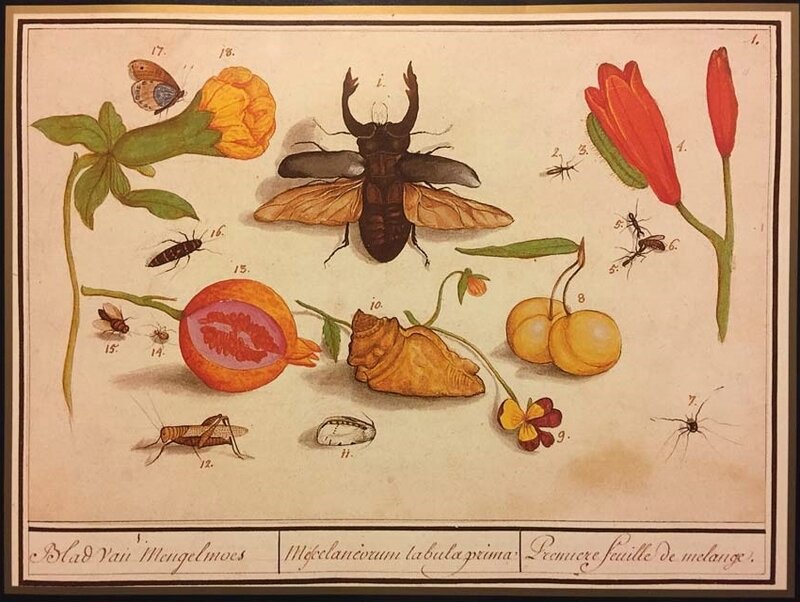TEFAF's top masterpiece goes to the Rijksmuseum
Anselmus de Boodt, Stag Beetle, Flowers, Fruit and other Insects, "Historia Naturalis" by Rudolf II, vol. VII, pl. 30.
AMSTERDAM.- One of the most extraordinary items on offer at this year’s TEFAF, the Natural History Paper Museum of Holy Roman Emperor Rudolph II, will be exhibited in the Rijksmuseum. The unique collection of 750 exquisite watercolours of animals, birds and plants from the late Renaissance period were compiled between 1596 and 1610 as a compendium of zoology and botany—a Historia Naturalis—by Rudolph II’s court physician, Anselmus de Boodt. The albums remained together for four centuries which accounts for the extraordinary condition of the watercolours, their colours still pristine. The albums have been purchased by a private collector and will be on long-term loan to the Rijksmuseum.
Taco Dibbits, General Director Rijksmuseum: "This was the absolute sensation at TEFAF. Rarely, if ever does something come on the market that was made for Emperor Rudolph II. The colours are particularly fresh, which makes the drawings lively and attractive to the eye. It's great that a private collector has made it possible for everyone to admire them".
Flowers, birds and ‘beasts’ with attitude
From common domestic and farmyard animals (dogs, cats, horses and cattle) to exotic creatures (ostrich, walrus, porcupine) and extinct ones (the dodo), and even a dragon ‘drawn from life’, the compendium offers a glimpse of the range of plants, animals and birds believed to exist at the dawn of the Dutch Golden Age. The drawings of plants and insects include irises, tulips, mushrooms, a pineapple, corn, sunflowers and red cabbage, among many others. Among the birds are eagles, owls, parrots, a kingfisher, turkey, etc. Although De Boodt aimed to supply a faithful ‘scientific’ reproduction of each living thing, the animal illustrations in particular have a lively, humorous air that sets them apart from earlier models. See, for instance, the amusing ostrich with his twisted neck and perplexed expression.
Anselmus de Boodt
The renowned naturalist, Anselmus de Boodt (1550-1632) drew, signed, or annotated the lion’s share of the drawings, and assembled or commissioned other examples by his contemporaries. With the death of the Emperor in 1612, bitter disputes erupted over outstanding bills at the imperial court. After failing to be reimbursed for his unpaid expenses, De Boodt removed the drawings from Prague and took them back to his native Bruges, where they remained in his family for the next two centuries.
Prague court of Rudoph II
Humanist learning flourished at the court of Rudolph II (1552–1612). Rather than trying to expand his territorial holdings, the Holy Roman Emperor sought to unlock the mysteries of the universe and to study and record all that was known of the animal and plant kingdoms. People were obsessed by nature and by its deeper structure and meaning. This remarkable collection of natural history illustrations shows what an exceptional centre of science, art and culture Prague was under the reign of Rudolph II.

/https%3A%2F%2Fprofilepics.canalblog.com%2Fprofilepics%2F1%2F0%2F100183.jpg)
/https%3A%2F%2Fstorage.canalblog.com%2F03%2F02%2F119589%2F96711876_o.jpg)
/https%3A%2F%2Fstorage.canalblog.com%2F11%2F31%2F119589%2F94773502_o.jpg)
/https%3A%2F%2Fstorage.canalblog.com%2F20%2F83%2F119589%2F94772815_o.jpg)
/https%3A%2F%2Fstorage.canalblog.com%2F26%2F72%2F119589%2F75604929_o.jpg)
/https%3A%2F%2Fstorage.canalblog.com%2F59%2F60%2F119589%2F26458628_o.jpg)



/image%2F1371349%2F20240425%2Fob_c453b7_439605604-1657274835042529-47869416345.jpg)
/image%2F1371349%2F20240425%2Fob_59c6f0_440358655-1657722021664477-71089985267.jpg)
/image%2F1371349%2F20240425%2Fob_07a28e_440353390-1657720444997968-29046181244.jpg)
/image%2F1371349%2F20240425%2Fob_0b83fb_440387817-1657715464998466-20094023921.jpg)